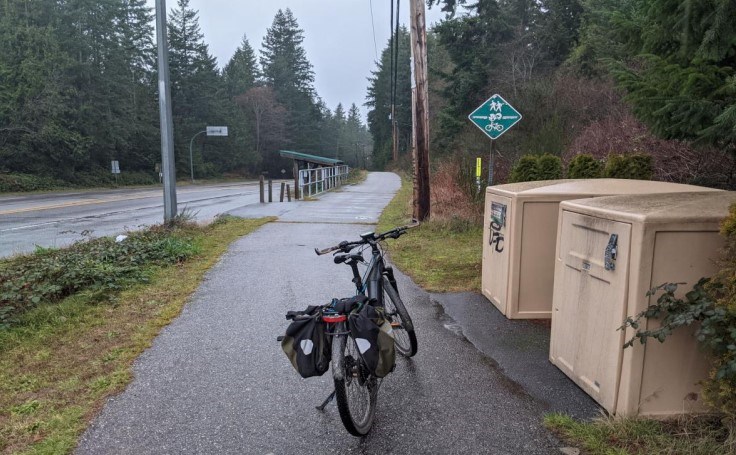Go By Bike Week is June 3 to 9 and another opportunity for Transportation Choices Sunshine Coast (TraC) to shine a light on local sustainable cycling, pedestrian and transit alternatives to single-occupancy car use.
Coast Reporter checked in with organization spokesperson Stephen Forgacs to get an update on efforts, including TraC’s ambitious “Connect the Coast” initiative. That work aims to create all ages and abilities cycling and pedestrian infrastructure to connect Sunshine Coast communities, eventually establishing a route linking the Langdale and Earls Cove ferry terminals and onwards to Powell River.
Amassing grant "matching funds"
On May 23, the Sunshine Coast Regional District board committed to provide $35,000 in matching funds should Connect the Coast, a registered charitable organization formed by TraC, be approved for a $140,000 federal grant it has applied for.
With the regional district’s action, Forgacs said the group has about $80,000 of matching funds confirmed with support also committed by Gibsons and Sechelt. As for sourcing the additional $60,000 of local funding to max out the federal contribution, more grant applications are on the horizon.
Completing applications is “largely done by the organization’s board of five people, who have varying degrees of experience” he stated. “We will call in expertise from university students or consultants as we try to do as much as we can with our limited budget… we are resourceful people and we will find ways to do this."
TraC’s board was not deterred by being turned down in a recent application for provincial Regional Economic Development and Infrastructure Program funding. Forgacs explained how the group sought out a debrief from that funding agency after the refusal. He said they were “encouraged to re-apply” and to include “more details on the potential economic impacts [of] a multi-use path from Langdale to Sechelt."
“We need to do more work to quantify what that impact may be” he noted. To get that done, he said TraC will be drawing on relationships it has built with Coast local governments and others like the Chamber of Commerce.
Donations are another important source of funds. In Forgacs' view, the Connect the Coast project “touches on the environment, climate change and providing transportation equity, which we believe aligns with the goals of the Coast's most generous philanthropists." Those with the resources to make major financial donations, smaller scale financial donors or those who want to help out the project by volunteering are all encouraged to reach out via the project webpage.
On the project planning front
Ensuring Connect the Coast can be built in a way that is aligned with what Ministry of Transportation and Infrastructure wants to achieve in the development of active transportation infrastructure, TraC has provided that organization with the preliminary study on the project. The local group also met with the minister last fall, and are making sure planning is in step with “processes MOTI would follow so that nothing has to be redone when we start moving towards construction,” Forgacs noted.
And that detailed planning for work on the Coast will move forward this year. TraC received a $5,000 grant from the BC Cycling Coalition, which Forgacs said will be applied to an environmental overview for the Pratt to Hyland Road section, linking Gibsons and Roberts Creek, to meet requirements of the Skwxwu’7mesh Nation.
At least 20 years to completion
As for an estimate of the date the full ferry-to-ferry all-access trail could be a reality, Forgacs said he “could not even speculate." One comparable that he described was the recently completed active transportation project connecting Ucluelet and Tofino, which he said took about 20 years from “the beginning of advocacy to the completion of the path."
“In many ways, that structure was easier as that one was basically along a highway bordered by forest lands, whereas we go through residential areas, commercial centres and is fairly complex. We are focused on chipping away at this piece by piece, with whatever resources we can muster. It is such a big and complex project I can’t see it unfolding as one long structure that’s completed in sequence. I imagine Gibsons to Roberts Creek section happening first, then the Sechelt to Davis Bay section, those are our priority segments."
A focus on future users
TraC continues work on other projects that promote use of healthy and sustainable transportation as well. Some of those are focused on changing Coasters' beliefs around and dependence on single occupancy vehicles for travel. Establishing active transportation as a viable alternative, requires not only the infrastructure like all access paths, but a shift in attitudes, according to Forgacs, who said that is sometimes simpler to do with younger generations.
He noted the organization was an advocate for the recent introduction of free transit for all youth. Through a second BC Cycling Coalition grant, he said the group is working with Vancouver Coastal Health and School District 46 on active transport routes into Cedar Grove and Langdale elementary schools with a goal of ensuring “kids and their families have to option to walk or cycle to school safely."



